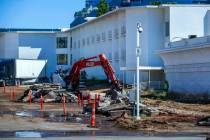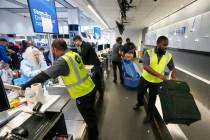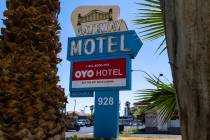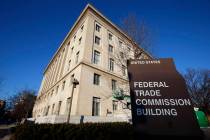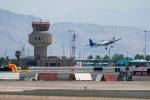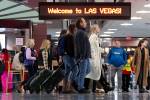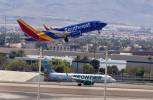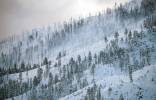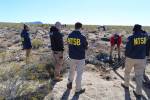Mixed reviews for local airports
A Federal Aviation Administration review of 20 airports around the nation found mixed runway-safety records at Southern Nevada's two biggest airports, government officials said Monday.
The rate of runway incursions at McCarran International Airport was low when compared with records at other big airports, but the North Las Vegas Airport posted the highest rate of runway incursions among the airports the federal agency reviewed.
McCarran had six runway incursions in fiscal 2007, which ended Sept. 30. That amounts to 0.97 incursions for every 100,000 takeoffs and landings. McCarran ranked 26th in the country for the number of runway incursions per 100,000 operations; airports with higher incursion rates included Los Angeles International, Chicago's O'Hare International, New York's LaGuardia International, Dallas-Fort Worth International, Atlanta Hartsfield Jackson International, San Francisco International and Boston's Logan International.
Runway incursions were more frequent at the North Las Vegas Airport. The airport posted 11 incursions in 2007, for a rate of 5.02 incursions per 100,000 takeoffs and landings.
Because more than half of the runway incursions at the North Las Vegas Airport involved pilots based there, problems likely stemmed from factors other than a lack of familiarity by pilots, said Ian Gregor, a spokesman for the Federal Aviation Administration.
Runway-safety prescriptions at both airports involve more-visible signs indicating airfield locations and runway intersections, fresh directional pavement markings and "hot-spot" placards alerting pilots to airfield sections with past incursion issues.
Additional safety measures at North Las Vegas could include videos for pilot training and an examination of "airfield geometry" to determine whether modifications in taxi ways might reduce incursions, Gregor said.
The simpler changes, such as signs and placards, should be in place within 60 days. Complicated solutions involving airway layouts could require six months to implement, Gregor said.
Cecil Johnson, who oversees operations at North Las Vegas as assistant director of aviation for general aviation at the Clark County Department of Aviation, said the airport has received several new runway-safety measures over the past two years. Lights to identify the end of runways, lights to alert pilots that they're leaving taxi ways and entering runways and taxi-way markings twice the size of indicators at other airports North Las Vegas' size are among the improvements, Johnson said.
Yet, human error still occurs, and that could have contributed to an increase in incursions in 2007 at North Las Vegas, Johnson said.
"We can't control the pilot who may be looking at his instrumentation, working his avionics or tuning up the engine in advance of taking off," Johnson said. "We have a lot of student activity at the airport as well, with four flight schools there."
Airport executives met in September with federal officials to discuss additional changes, and they're asking pilots and flight-school operators based at the airport to pass along suggestions for safety upgrades.
Local aviation officials have also made runway-safety upgrades at McCarran. The airport added brighter and bigger airfield markings to guide pilots more than a year before the Federal Aviation Administration required completion of the work. The improvements helped McCarran land the agency's regional Air Carrier Airport Safety Award for 2007 in May, Johnson said.
Johnson also noted that McCarran's runway incursions have remained low even as construction continues on several major projects, including a new terminal.
Gregor said neither McCarran nor North Las Vegas experienced any serious runway incursions in 2007. The agency grades incursions on a four-letter scale, with A being the most serious and D being the least serious. Neither airport experienced A or B incursions in 2007; at McCarran, all six incursions were D-level, which means no chance of a collision during the event. Ten of the North Las Vegas Airport's incursions were D-level, and one was C-level.
Gregor said passengers should feel "very, very comfortable" flying into McCarran. And though North Las Vegas needs safety improvements, flyers using that airport needn't be overly concerned about runway incursions there, he added.
"The good news is that the vast majority of runway incursions at North Las Vegas are of the less-serious kind," Gregor said. "It's a safe airport, but we definitely want to make it safer. There have been too many runway incursions there, and we're going to change that."
Airports nationwide have made progress in limiting severe incursions, federal officials said Monday in a phone-in press conference.
The number of A- and B-level incursions dropped from 31 in fiscal 2006 to 24 in fiscal 2007, and the number of C-level incursions fell from 75 in 2006 to 49 in 2007. The number of D-level incursions jumped, however, from 224 in 2006 to 298 in 2007. Though D-grade incursions don't involve collision hazards, the gain in occurrences raised eyebrows at the Federal Aviation Administration because D-level incursions are "precursor events," said agency administrator Bobby Sturgell.








